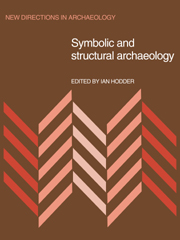Book contents
- Frontmatter
- Contents
- List of contributors
- Preface
- Part one The development of theory
- Part two The search for models
- 5 Matters material and ideal
- 6 House power: Swahili space and symbolic markers
- 7 The interpretation of spatial patterning in settlement residues
- 8 Decoration as ritual symbol: a theoretical proposal and an ethnographic study in southern Sudan
- 9 Structures and strategies: an aspect of the relationship between social hierarchy and cultural change
- 10 Mortuary practices, society and ideology: an ethnoarchaeological study
- Part three Application: the analysis of archaeological materials
- Part four Commentary
- Index
7 - The interpretation of spatial patterning in settlement residues
Published online by Cambridge University Press: 27 February 2010
- Frontmatter
- Contents
- List of contributors
- Preface
- Part one The development of theory
- Part two The search for models
- 5 Matters material and ideal
- 6 House power: Swahili space and symbolic markers
- 7 The interpretation of spatial patterning in settlement residues
- 8 Decoration as ritual symbol: a theoretical proposal and an ethnographic study in southern Sudan
- 9 Structures and strategies: an aspect of the relationship between social hierarchy and cultural change
- 10 Mortuary practices, society and ideology: an ethnoarchaeological study
- Part three Application: the analysis of archaeological materials
- Part four Commentary
- Index
Summary
Moore argues, in the introduction to this paper, that the analogies suggested by ethnoarchaeology should be structural rather than formal. The category ‘rubbish’ in settlement studies must be located and understood within cultural contexts, including the archaeologist's own society. The notion of curation is shown to be culturally variable and to have varying significance. The organisation and categorisation of refuse must be linked to data on burial, settlement, decoration, formalised ritual and so on within a cultural context. Such relationships are identified by reference to an initial survey of the Marakwet of Kenya. This study demonstrates ways in which the archaeologist could link refuse organisation to other types of data within a cultural context.
Ethnoarchaeology is one of the fastest growing areas within archaeology, and its general development reflects some of the current problems in archaeological theory. The term ethnoarchaeology covers a broad range of interests but I would like to restrict my discussion here to those studies which are concerned with the interpretation of intra-site spatial patterning in material remains and with the cultural factors which affect the formation of the archaeological record.
Ethnographic analogy
One of the main problems in archaeological explanation with which ethnoarchaeology has been most closely associated is the use of analogy. Under the influence of the New Archaeology, analogy became a ‘dirty word’; it became associated with culture historians and with attempts to provide an ‘historical’ rendering of the past. While it was grudgingly admitted that analogy could not be avoided, most New Archaeologists felt that its role in archaeological explanation should and could be reduced to a minimum.
- Type
- Chapter
- Information
- Symbolic and Structural Archaeology , pp. 74 - 79Publisher: Cambridge University PressPrint publication year: 1982
- 26
- Cited by



